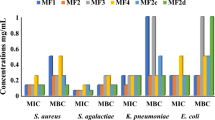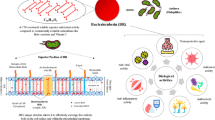Abstract
Essential oils and their main components, monoterpenes, have been proven to be important alternatives for the control of pathogenic and spoiling microorganisms, but the mode of action of these compounds is poorly understood. This work aimed to determine the mode of action of citral and geraniol on the model yeast Saccharomyces cerevisiae using a flow cytometry approach. Exponentially growing yeast cells were treated with different concentrations of citral and geraniol for 3 h, and evaluated for cell wall susceptibility to glucanase, membrane integrity, reactive oxygen species (ROS) accumulation, mitochondrial membrane potential, and metacaspase activity. Results provide strong evidence that citral and geraniol acute fungicidal activity against Saccharomyces cells involves the loss of membrane and cell wall integrity resulting in a dose-dependent apoptotic/necrotic cell death. However, yeast cells that escape this first cell membrane disruption, particularly evident on sub-lethal concentration, die by metacaspase-mediated apoptosis induced by the accumulation of intracellular ROS. The deleted mutant on the yca1 gene showed high tolerance to citral and geraniol.
Graphic abstract






Similar content being viewed by others
References
Bakkali F, Averbeck S, Averbeck D, Idaomar M (2008) Biological effects of essential oils–a review. Food Chem Toxicol 46:446–475
Bard M, Albrecht MR, Gupta N, Guynn CJ, Stillwell W (1988) Geraniol interferes with membrane functions in strains of Candida and Saccharomyces. Lipids 23:534–538
Bennis S, Cami F, Chami N, Bouchikhi T, Remmal A (2004) Surface alteration of Saccharomyces cerevisiae induced by thymol and eugenol. Lett Appl Microbiol 38:454–458
Bergman ME, Davis B, Phillips MA (2019) Medically useful plant terpenoids: biosynthesis, occurrence, and mechanism of action. Molecules 24:3961
Brennan TC, Krömer JO, Nielsen LK (2013) Physiological and transcriptional responses of Saccharomyces cerevisiae to d-limonene show changes to the cell wall but not to the plasma membrane. Appl Environ Microbiol 79:3590–3600
Carmona-Gutierrez D, Eisenberg T, Büttner S, Meisinger C, Kroemer G, Madeo F (2010) Apoptosis in yeast: triggers, pathways, subroutines. Cell Death Differ 17:763–773
Chaouki W, Leger DY, Liagre B, Beneytout JL, Hmamouchi M (2009) Citral inhibits cell proliferation and induces apoptosis and cell cycle arrest in MCF-7 cells. Fundam Clin Pharm 23:549–556
Chatrath A, Gangwar R, Kumari P, Prasad R (2019) In Vitro anti-biofilm activities of citral and thymol against Candida tropicalis. J Fungi 5:13
Chueca B, Pagan R, Garcia-Gonzalo D (2014) Oxygenated monoterpenes citral and carvacrol cause oxidative damage in Escherichia coli without the involvement of tricarboxylic acid cycle and Fenton reaction. Int J Food Microbiol 189:126–131
Dubois-Brissonnet F, Naitali M, Mafu AA, Briandet R (2011) Induction of fatty acid composition modifications and tolerance to biocides in Salmonella enterica serovar typhimurium by plant-derived terpenes. Appl Environ Microbiol 77:906–910
Farrugia G, Balzan R (2012) Oxidative stress and programmed cell death in yeast. Front Oncol 2:64
Fedoseeva IV, Pyatrikas DV, Stepanov AV, Fedyaeva AV, Varakina NN, Rusaleva TM, Rikhvanov EG (2017) The role of flavin-containing enzymes in mitochondrial membrane hyperpolarization and ROS production in respiring Saccharomyces cerevisiae cells under heat-shock conditions. Sci Rep 7:1–14
Gaonkar R, Aytic P, Hegdeb G (2018) Differential antifungal efficiency of geraniol and citral. Nat Prod Commun 13:1609–1614
Karathia H, Vilaprinyo E, Sorribas A, Alve R (2011) Saccharomyces cerevisiae as a model organism: a comparative study. PLoS ONE 6:e16015
Kim SH, Bae HC, Park EJ, Lee CR, Kim BJ, Lee S, Park HH, Kim S, So I, Kim TW, Jeon JH (2011) Geraniol inhibits prostate cancer growth by targeting cell cycle and apoptosis pathways. Biochem Biophys Res Commun 407:129–134
Konuk HB, Ergüden B (2017) Antifungal activity of various essential oils against Saccharomyces cerevisiae depends on disruption of cell membrane integrity. BioCell 41:13–18
Leite MCA, Bezerra APDB, Sousa JPD, Guerra FQS, Lima EDO (2014) Evaluation of antifungal activity and mechanism of action of citral against Candida albicans. Evid-Based Compl Altern Med. https://doi.org/10.1155/2014/378280
Li RY, Wu XM, Yin XH, Liang JN, Li M (2014) The natural product citral can cause significant damage to the hyphal cell walls of Magnaporthe grisea. Molecules 19:10279–10290
Lima IO, de Medeiros Nóbrega F, de Oliveira WA, de Oliveira Lima E, Albuquerque Menezes E, Afrânio Cunha F, de Fátima Formiga Melo Diniz M (2012) Anti-Candida albicans effectiveness of citral and investigation of mode of action. Pharm Biol 50:1536–1541
Pandey AK, Pradeep K, Pooja S, Tripathi NN, Bajpai VK (2017) Essential oils: sources of antimicrobials and food preservatives. Front Microbiol 7:2161
Ramak P, Osaloo KS, Sharifi M, Ebrahimzadeh H, Behmanesh M (2014) Biosynthesis, regulation and properties of plant monoterpenoids. J Med Plants Res 8:983–991
Scariot FJ, Jahn LM, Maianti JP, Delamare APL, Echeverrigaray S (2016) The fungicide Mancozeb induces metacaspase-dependent apoptotic cell death in Saccharomyces cerevisiae BY4741. Apoptosis 21:866–872
Scariot FJ, Jahn L, Delamare APL, Echeverrigaray S (2017) Necrotic and apoptotic cell death induced by Captan on Saccharomyces cerevisiae. World J Microbiol Biotechnol 33:159
Scariot FJ, Foresti L, Delamare APL, Echeverrigaray S (2020) Activity of monoterpenoids on the in vitro growth of two Colletotrichum species and the mode of action on C. acutatum. Pestic Biochem Phys 170:104698
Sharma Y, Khan LA, Manzoor N (2016) Anti-Candida activity of geraniol involves disruption of cell membrane integrity and function. J Mycol Med 26:244–254
Shi C, Song K, Zhang X, Sun Y, Sui Y, Chen Y, Jia Z, Sun H, Sun Z, Xia X (2016) Antimicrobial activity and possible mechanism of action of citral against Cronobacter sakazakii. PLoS ONE 11:e0159006
Singh S, Fatima Z, Ahmad K, Hameed S (2018) Fungicidal action of geraniol against Candida albicans is potentiated by abrogated CaCdr1p drug efflux and fluconazole synergism. PLoS ONE 13:e0203079
Strich R (2015) Programmed cell death initiation and execution in budding yeast. Genetics 200:1003–1014
Tang X, Shao YL, Tang YJ, Zhou WW (2018) Antifungal activity of essential oil compounds (geraniol and citral) and inhibitory mechanisms on grain pathogens (Aspergillus flavus and Aspergillus ochraceus). Molecules 23:2108
Wang CY, Chen YW, Hou CY (2019) Antioxidant and antibacterial activity of seven predominant terpenoids. Int J Food Prop 22:230–238
Winska K, Maczka W, Tyczko J, Grabarczyk M, Czubaszek A, Szummy A (2019) Essential oils as antimicrobial agents—myth or real alternative? Molecules 24:2130
Wloch-Salamon DM, Bem AE (2012) Type of cell death and methods of their detection in yeast Saccharomyces cerevisiae. J Appl Microbiol 114:287–298
Xia H, Liang W, Song Q, Chen X, Chen X, Hong J (2013) The in vitro study of apoptosis in NB4 cell induced by citral. Cytotechnology 65:49–57
Ye CJ, Li SA, Zhang Y, Lee WH (2019) Geraniol targets KV1. 3 ion channel and exhibits anti-inflammatory activity in vitro and in vivo. Fitoterapia 139:104394
Zhang YF, Huang Y, Ni YH, Xu ZM (2019) Systematic elucidation of the mechanism of geraniol via network pharmacology. Drug Des Devel Ther 13:1069–1075
Zheng S, Jing G, Wang X, Ouyang Q, Jia L, Tao N (2015) Citral exerts its antifungal activity against Penicillium digitatum by affecting the mitochondrial morphology and function. Food Chem 178:76–81
Zhou HE, Tao NG, Jia L (2014) Antifungal activity of citral, octanal and alpha-terpineol against Geotrichum citri-aurantii. Food Control 37:277–283
Zore GB, Thakre AD, Jadhav S, Karuppayil SM (2011) Terpenoids inhibit Candida albicans growth by affecting membrane integrity and arrest of cell cycle. Phytomedicine 18:1181–1190
Acknowledgements
This work was financially supported by the National Council for Scientific and Technological Development-CNPq (431538/2016-6, and 304906/2017-4) and the Coordenação de Aperfeiçoamento de Pessoal de Nivel Superior (CAPES, finance code 001). The authors acknowledge Cytogene Diagnósticos Moleculares Ltda. for access to flow cytometry equipment.
Author information
Authors and Affiliations
Corresponding author
Ethics declarations
Conflict of interest
The authors declare no competing interests.
Additional information
Publisher’s note
Springer Nature remains neutral with regard to jurisdictional claims in published maps and institutional affiliations.
Rights and permissions
About this article
Cite this article
Scariot, F.J., Pansera, M.S., Delamare, A.P.L. et al. Citral and geraniol induce necrotic and apoptotic cell death on Saccharomyces cerevisiae. World J Microbiol Biotechnol 37, 42 (2021). https://doi.org/10.1007/s11274-021-03011-8
Received:
Accepted:
Published:
DOI: https://doi.org/10.1007/s11274-021-03011-8




